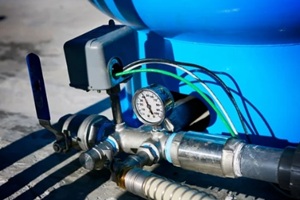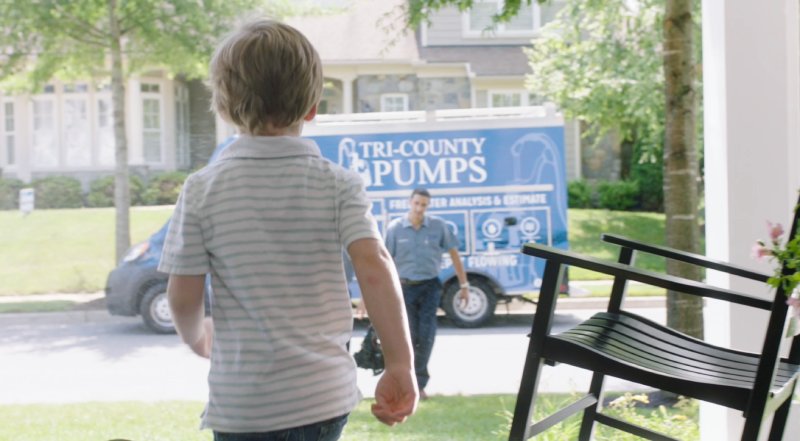
Homeowners with private wells often run into questions about water pressure, especially when dealing with inconsistent showers, sputtering faucets, or short-cycling pumps. Knowing the right pressure settings for your well pump can improve comfort, protect plumbing fixtures, and even extend the life of your system.
This article explains how to determine and maintain the correct well pump pressure for your home.
Why Well Pump Pressure Matters
Low pressure can make showers feel weak and cause dishwashers to under-perform, while high pressure can wear out plumbing fixtures and shorten the lifespan of your pump.
Most modern plumbing fixtures work best between 40 to 60 PSI, and a typical showerhead needs at least 2 gallons per minute at this range to feel comfortable.
Pressure that is too high, particularly above 80 PSI, can cause problems such as leaky faucets, blown seals in appliances, and water hammer (sudden pipe vibrations from abrupt pressure changes).
The Uniform Plumbing Code and the International Residential Code both define 80 PSI as the safe upper limit for static water pressure. Anything higher requires a pressure-reducing valve to protect your plumbing system.
Short-cycling is another concern. When the pressure switch turns the pump on and off too quickly, the motor can overheat, and the pressure tank can wear out prematurely.
What Controls Well Water Pressure
A well water system relies on multiple parts working together to control and maintain water pressure.
Pressure Switch
Serving as the system’s trigger, the pressure switch determines when the pump activates. When the pressure in your water line falls below a preset level, the switch detects it and signals the pump to start.
Most residential systems use a 30/50 or 40/60 switch, meaning the pump turns on at 30 or 40 PSI and shuts off at 50 or 60 PSI. Adjustments to these settings should be made carefully to match the capacity of your system.
Pressure Tank
A pressure tank holds water and helps keep pressure steady throughout your plumbing system. To function correctly, the tank is pre-filled with air, usually at a pressure 2 PSI below the point when the switch activates the pump.
For a 40/60 setup, the tank should read 38 PSI when empty. Having this buffer of pressurized air reduces how often the pump needs to run, lowering wear and energy use.
Pressure Gauge and Pump
A pressure gauge shows the current system pressure and is usually mounted near the tank. Pumps can be traditional submersible models or modern variable frequency drives (VFDs).
VFDs offer constant pressure by adjusting motor speed to meet demand, keeping pressure steady throughout the day. These systems often run in the 50 to 70 PSI range and are ideal for larger or multi-story homes.
Choosing the Right Pressure Range
The right pressure range depends on the distinct layout of your home, fixture types, and plumbing system:

- 20/40 PSI: Suitable for shallow wells or simple irrigation systems. It moves a lot of water gently, but may feel weak on upper floors.
- 30/50 PSI: Common in older homes or one-story houses with standard plumbing.
- 40/60 PSI: A reliable standard for most newer homes. It delivers solid pressure without stressing the system.
- 50/70 PSI: Best for large homes with multiple bathrooms, modern fixtures like rainfall showerheads, or irrigation systems. Equipment like pipes and pressure tanks must have a pressure rating of 100 PSI or higher to operate safely in this setup.
Always stay below 80 PSI unless a pressure-reducing valve is installed, and confirm your equipment is rated for the pressure level you choose.
Calculating What Your System Needs
To figure out the right pressure, consider three things: elevation, fixture performance, and friction losses:
- Elevation gain: Every foot of vertical rise reduces pressure by 0.433 PSI. For instance, a bathroom 30 feet above the pressure tank requires about 13 PSI just to reach the faucet.
- Fixture requirements: Most modern fixtures work best between 40 to 60 PSI. If you’re aiming for 50 PSI at a showerhead on the top floor, add the elevation loss and any other reductions.
- Friction and treatment losses: Water softeners, sediment filters, or UV systems can drop pressure by 3 to 5 PSI each.
So, a system serving a three-story home with treatment equipment and a 50 PSI shower target would need around 68 PSI at the tank. In this case, a 50/70 switch or VFD setup would be a smart choice.
Maintaining Proper Pressure
Keeping your pressure tank and switch in good shape avoids performance dips and costly damage.
Checking and Recharging the Tank
Make sure to turn off the pump and drain the system before checking the tank pressure. Use a tire gauge on the Schrader valve and adjust the pressure to 2 PSI below the cut-in point of the switch. Recheck every 12 months or after changing switch settings.
Some technicians recommend a slightly larger gap (3 to 5 PSI) between tank charge and cut-in for high-pressure setups to prevent water-logging.
Adjusting the Pressure Switch
Before adjusting, confirm your pump can handle the change. Overloading a small pump can cause stalling or overheating.
Start by shutting off the power, then carefully remove the pressure switch cover and identify the adjustment nuts inside:
- The larger nut raises or lowers both the cut-in and cut-out together.
- The smaller nut changes the differential, usually kept at 20 PSI.
Each full turn usually adjusts pressure by about 3 PSI. After changes, turn the system back on, confirm the new pressure range, and don’t forget to readjust the tank to match the new cut-in setting.
Diagnosing Pressure Problems
Some common problems may show up in predictable ways. Watch for these signs to figure out what’s happening:
- Bouncing gauge: Tank is too small or pump is oversized.
- Sudden surges: Bladder may have failed, or tank needs recharging.
- Constant high pressure: Switch contacts stuck or pressure-reducing valve has failed.
- Rapid pump cycling: Dirty switch contacts or incorrect differential.
Routine annual checks, including amp draws and flow tests, help catch issues early. Switches generally last 5 to 7 years, and replacing them on schedule helps avoid sudden failures.
Getting Well Pump Pressure Right for Long-Term Performance

Having accurate knowledge of pressure ranges supports system efficiency and reliability, preventing common problems across various home configurations, including multi-level layouts and systems with water treatment.
At Tri-County Pump Service, we’ve been helping homeowners across Maryland, Virginia, and West Virginia since 1991. If your water pressure has been unpredictable or you’re ready to upgrade to a system that fits the needs of your home, we’re here to help. You can call our main office at 1-(301)-432-0330, use our online contact form, or schedule service directly through our website.



